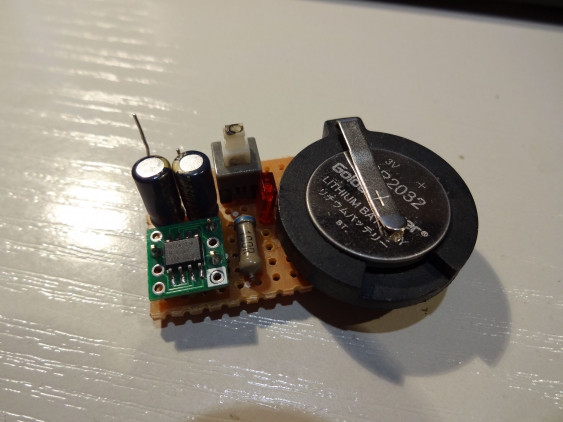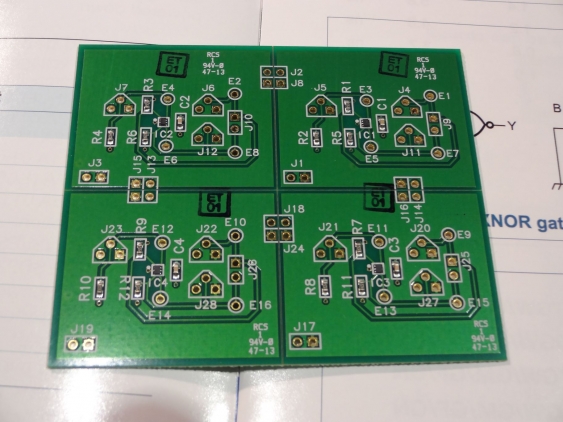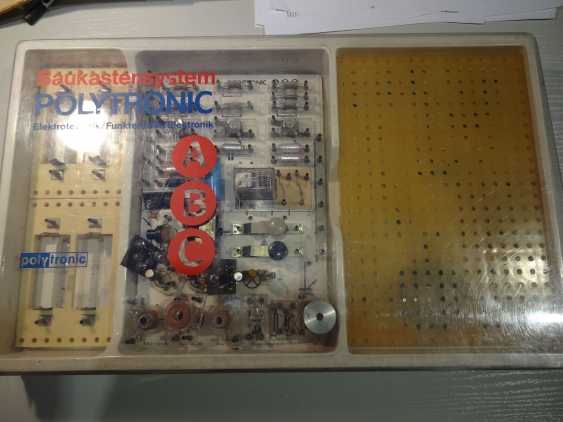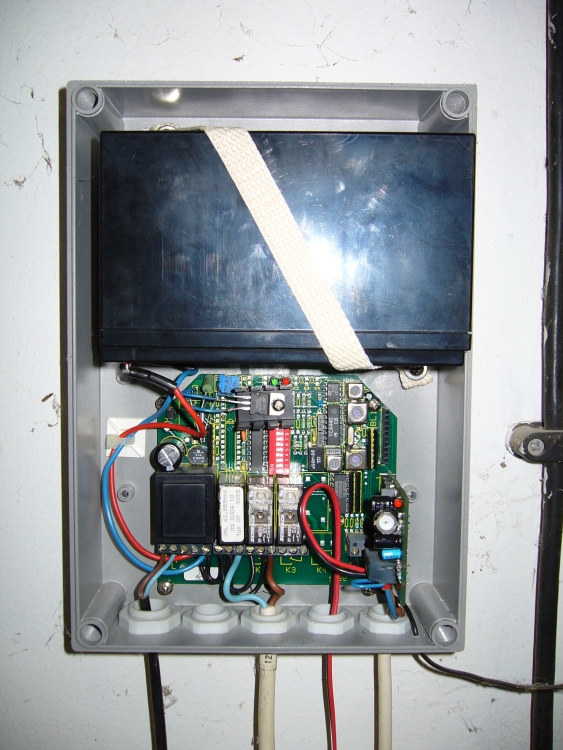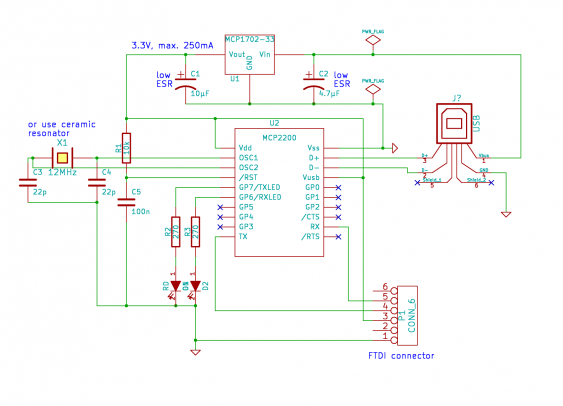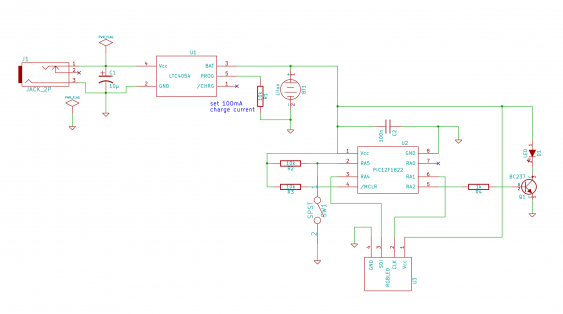34 items are tagged with projects:
wireless power - status update 2
So what happened in the last two weeks? As already mentioned, I finalized the PCB and send it away. I did go with Würth in the end. They were not the cheapest of the lot, but provided the most bang for the buck. I got 5 day manufacturing time (and since they deliver with courier, probably even from Germany, delivery also takes only one day). Also, they did not charge extra for silkscreen or solder resist (as may happen with cheaper manufacturers). And last but not least I got Ni/Au plating for still the same price, which is not only better for long-term usage, but also better than HASL for SMD soldering. So I send the board files off to WEdirekt (no need to convert them to Gerbers), and thanks to Simon Leuz I even got a 10 percent rebate
Continue readingWireless Power - the full schematic explained
Since the contest is now nearing its completion, I gather its about time to actually show and explain the whole circuit. I already went through some of the parts of it, and how I decided how to build it. But I never showed how these parts work together. So lets have a look.
Continue readingwireless power - status update
So the last couple of weeks was silent with regards to my project - I was just too busy. Being on a business trip left not so much time for doing electronic projects (and I forgot to take the Eagle project with me). And the aftermath was then rather busy at work.
But I got new transmitter coils from Würth in the mean time, and did some experiments with them (which need a write-up).
Apart from that I have finalized my schematic, and added all the missing details I already explained the most important parts of it, but there are still some minor tweaks here and there. So there will be a separate post about it.
Continue readingBuilding a multi-voltage reference for my DMMs
A while ago I saw in the Dangerousprototypes forums a nice project: MrRef. Its a small voltage reference, intended to verify that a digital multimeter is still within its spec. Normally one would use either a real high-precision meter (like the Agilent 3458A) or a really good, calibrated voltage reference. But these are not exactly cheap, and probably overkill for a 50$ (or cheaper) multimeter. So matseng took a not so expensive voltage reference (a MAX6350, but it onto small breakout board, together with 4 batteries, and had something which is at least more accurate than the normal hobbyists multimeter.
Seeing this I did something similar - but I used a REF5020 from TI instead:
but it was not as accurate as I would have liked (the initial accuracy is 0.1%), and the 2.048 Vv output voltage meant that its just over the range for a 2000 counts multimeter (so it read 2.05).
So when I bought a new multimeter last fall (two UT61E actually), I looked into building a new, more accurate reference, with a wider range of voltages.
Continue readingwireless power - battery under-voltage lockout with multiple cells
When designing systems powered by rechargeable batteries, especially LiIon batteries, its important to ensure that the batteries are not discharged too much. For primary cells this is not a problem (except that the device won’t work anymore), but secondary cells can be permanently damaged by such a deep discharge. normally this just results in permanently reduced capacity (which is bad enough). But a LiIon battery that has been discharged too deep can actually catch fire (that happens when its charged again, since during discharge internal shorts can form inside the battery). So an under-voltage safety mechanism has to be used to ensure that never happens. Basically all single cell LiIon batteries already come with such a circuit (most times inside the case already). Many battery packs too come with it, but especially pack for RC models do not, since the high current there make that difficult. A typical cut-off voltage is about 2.5 V, sometimes as low as 2.3 V. That is a voltage where the capacity might be permanently reduced already. So I would like to have the cut-off voltage higher, at about 2.9-3.0 V. That means building my own under-voltage-lockout (or UVLO)
Such a safety mechanism gets a little bit more complicated in the case of a battery pack, since there the cut-off needs to happen when just one cell gets discharged below this voltage. So lets look how we might implement that.
Continue readingAXP configurable logic design contest wrapup
So its time to finalize my project for the AXP Logic design contest. After having looked at the evaluation board, explained the electronic circuit as well as how I build the rest of the project, the last part the rules are calling for is a small essay describing my experiences with the AXP logic gates, the evaluation board and the project in general.
Continue readingHow to build a "most useless machine"
As promised last time, this article is about finally building the most useless machine of them all. When explaining the electronic / logic side of this project, I already talked a little bit about how it works. But now its time for some details.
The basic idea is rather simple: there a motor, connected to an arm. On the outside of the enclosure is a switch, which turns the motor on. The arm then moves the switch into its original position, and returns into the enclosure afterwards:
Continue readingTwo times is not enough - Measuring the performance of the wireless power demo kit part 3
Wuerth Elektronik was so kind to provide me with some additional coils to be used with Qi-compatible transmitters (and receivers). I actually asked, when receiving he offer, just for a specific one. But someone at Wuerth thought it might be better to send two for every single one they have in stock (which is four different types).
So now I have to decide which one is suited best for my purposes - and that means another round of measurements…
Continue readingTwo times is not enough - Measuring the performance of the wireless power demo kit part 3
Wuerth Elektronik was so kind to provide me with some additional coils to be used with Qi-compatible transmitters (and receivers). I actually asked, when receiving he offer, just for a specific one. But someone at Wuerth thought it might be better to send two for every single one they have in stock (which is four different types).
So now I have to decide which one is suited best for my purposes - and that means another round of measurements…
Continue readingWireless power contest - strategies for charging a battery pack, part 3
In the first two parts of my wire less power contest series I had a look at options how to handle the charging of a battery pack. Either by dividing it into single cells or using a cell balancing solution. But I always supposed that there is a charge controller doing the important part of controlling charge current and end-of-charge termination. Now its time to look at this piece of the puzzle.
Continue readingHow to design a "most useless machine" with some logic gates
So it really took me a long time to come up with the (hopefully…) final design for such a useless machine. Having some basic conditions for what parts to use for this project influenced many decisions, and made some things more complicated than originally planned. So lets have a deeper look into my solution.
First, I will explain what I used for this project, and how this shaped my decisions (and what problems arose from that). Next I will go through the whole schematic, explaining section by section my design. And last but not least I will show briefly how all of this looks in real life.
Continue readingWireless power contest - strategies for charging a battery pack, part 2
In the last part of my wire less power contest article I had a look at options for charging a battery pack by dividing it into single cells for charging. Since all the options proved to be too complicated for my purposes, I will take a look at how to charge the battery pack at once.
Continue readingWireless power contest - strategies for charging a battery pack, part1
When deciding for my basic plan to use a LiIon battery pack, I already knew that charging a LiIon battery pack will probably be the biggest challenge right now. So now it gets time for looking deeper into the issues of that problem.
Continue readingWireless power contest - outlining the basic plan
After I changed plans for last week, and did a second round of measurements, its now about time to write a little bit more about the actual project.
The basic idea is to augment an existing RC car by removing its battery pack, and to replace it with a Li-Ion battery. This battery then should get charged by wireless power transfer. Then its enough for my son to just take the car, put it on the charger station before going to sleep, and it should be ready the next day.
Continue readingMeasuring the performance of the wireless power demo kit - an update
When measuring the performance of the wireless power demo kit, I forgot to look at the efficiency. So I repeated my test series, but also measured the current consumption of the transmitter board.
I also ordered a cheap Qi receiver off eBay. Since my son has more than just a single toy I intended it to be used for other ones. Since it comes from China I did not expect to it get before a month or so, but shipping was really fast this time. So I found it in my mail on Thursday, and added it to the test series.
Continue readingMeasuring the performance of the wireless power demo kit
When talking about wireless charging, one of the questions that always come up is: what are the distances this will work for? I did answer this question already for another wireless charging kit, so I was curious what the Qi (or WPC) standard had ins store.
I’m interested in the maximum distance that is suitable for transferring a significant amount of power. Especially I wanted to know how well the transmit and receive coils need to be aligned with each other. After all, we are talking about a kid and its toys - one cannot expect millimeter precision when trying to charge to a toy over night.
Continue readingAXP1G57 configurable logic demo board - first impressions
So the evaluation board from NXP has arrived safely. Its larger than I expected (about 7.5 by 6 cm) - because its four boards in one:
Each of the four parts of the board contains a single 74AXP1G57 chip (the really small blob in the middle), surrounded by connectors to all pins, and the needed passive components (and even some more).
Continue readingUnboxing the Wireless power demo kit - first impressions
So Würth was really fast with sending the Wireless power demo kit - one of the advantages of living in Germany :)
This is what I found after opening the package:
If you look closely, you see the small tweezers on the right. Indeed - more than I expected from a demo kit…
Continue readingAnother month, another contest - gimme wireless power!
Sometimes my timing is just bad. When I applied for the AXP configurable logic contest end of last year, I didn’t know that there would be another contest waiting for me. But when I stumbled on the Beyond the phone challenge by Element14, I could not resist to register for that too. It falls into my “I always wanted to do that” category…
When I started adding wireless charging to my sons night light, I already knew that this would be useful for other toys too. So this contest was the perfect excuse to start working on that. And there was even the perfect object to be modified:
Continue readingAnother year, another contest
Since already have way to many project on my waiting list, I participate less in design contests than I used to. (I didn’t even come around to describe the projects I already did for them).
So when I stumble over one, I look whether it sound interesting or not. Sometimes there are interesting prices (I still need a decent scope beside my iMSO104), sometimes the idea is just fun (like for the last one). Sometimes the contest theme hits a nerve and its something I always wanted to play with.
When NXP informed me about their new “AXP logic design contest”, I was wondering in which category I should put it. The prices where not really for geeks of electronics engineers. And Doing something useful with just four configurable logic gates?
Continue readingContinuous temperature monitoring
Two years ago, when we returned from our skiing vacation, there was a nasty surprise waiting for us: with outside temperatures of down to -20° (celsius), our heating system had shut down. At one point, the pilot flame went out, and without it the heater could switch on again. I don’t know the reason for that (and it hasn’t happened since then), maybe there was a drop in gas pressure. Fortunately the temperatures were not so low for the vacation of last year, but for this year I decided I would like to be able to handle this problem.
Since I cannot really alert the service technician automatically (maybe I could, but he wouldn’t get into the house anyway), I want to know at least that there is some kind of a problem. Some I need some kind of temperature monitoring.
Continue readingSome more memories
While looking at my parents attic for some old stuff of mine I not only found my old electronics experimenters kit, but also my old Lego boxes. My son already got the more generic bricks I owned as a kit (together with all the sets he got for Christmas and his birthdays already). But I also owned a whole lot of Lego Technic sets, and bought myself a Mindstorms RIS shortly after they came out. And while digging around in the attic I found the latter one…
This is the original RCX version 1.5, still complete with the yellow brick and the infrared tower (connected via serial port). I also added the accessory kit later on.
Continue readingOld memories, old electronics kit and a new contest
I started my career in electronics (just a private one…) when I was a kid, more than 20 years ago. Growing up in East Germany meant that possibilities and access to e.g. components or tools were rather limited. One of the most useful items for learnings was an electronics kit which I used for many experiments, and which was and important tool to gather an understanding of what’s happening in an electronic circuit.
So I was really delighted when I found, several months ago, this electronics experimenters set on my parents attic (while cleaning out some of my old stuff still stored there):
Continue readingPimping a kids night-light - finale grande
It really took a while to finish this project. Mainly this was because the object to be modified is in constant use, especially when I got some time to work on it. So when the rest of my family recently was away for a weekend, I took my chance.
To recap: the remaining task was to make use of the wireless charger module. I already figured out that it can supply enough current to charge the LiIon battery I installed in the night light. I also looked at the question whether its safe to be put into a kids bed.
Continue readingPlaying with a TCXO
When I started working on the frequency meter project using the PSoC, I thought it might be a good idea to get better accuracy than the normal crystal oscillator could deliver. After all, it should be more accurate than the usual gated timer version you can find on Google. A crystal oscillator (like the SG531-40 I have in my parts bin gives an accuracy of about 50-100 ppm - so it can be 0.01% off (so at 10 kHz it could be off by 1 Hz). On the other hand, the temperature-compensated oscillator (TCXO) I bought on ebay (a TCO-986) is specified with 0.5ppm - so its more accurate by a factor of 100. The TCXO also has a much lower drift over temperature and time, so it will stay accurate over a longer time. So the idea was to put this oscillator on a breakout board (it comes in SMD package) and then use it for the frequency meter.
Continue readingA self-powered battery tester with an EFM32
I like to participate in electroics design contest. Its always interesting to apply skills within a given timeframe, most times also within a given frame of what to do. Many times its also a chance to get your hands on interesting hardware one would never buy otherwise. Most times I have participated so far was because the theme of the contest (or the hardware to be used) gave me the idea for an interesting project - so its most times just an excuse to build something for fun…
The same happened when Energy Micro announced, last september, their EFM32 Giant Gecko design contest. The theme was, as one would expect from Energy Micro, energy efficency. When I read about it, there came two recent events to my mind. First I had, a couple of weeks ago, disassembled a defective car temperature sensor, which left me with a single AA-cell battery holder still lying around. Second, I had many times before (and with an increasing rate) the problem to find whether some particular battery from the child toys in out household still have some energy in them or not. Until then I always I used a cheap multimeter for that which had a “battery measurement” range, but it gave only a number betwen (typically) 20 and 40, and I never knew whether that was supposed to be good or not.
So the idea hat came to my mind was: why not build a proper battery meter which can give real and accurate numbers. That can’t be so complicated! And since the EFM32 is so low-power, why not make it powered from the battery I’m currently measuring? Drawing some additional microamps from it can hardly change the results…
So I applied with this idea (and second one to, but this will be another post), and got accepted for the next round in the contest (only 40 ideas were accepted overall). So some weeks later I got a STK3700 with a EFM32GG on it my mailbox:
Continue readingBuilding a PicKit 2 clone
For most of my smaller projects using a high-performance MCU (like a Stellaris, now Tiva, STM32F or Cypress PSoC) is kind of overkill. Their power is not always needed and their requirements regarding supply voltages make the projects more complicated and expensive (they run with 3.3V only, so level conversion might be needed, and some additional LDO). And most of them are available on large (and small-pitch) packages only, making bread-boarding and the final PCBs more difficult. So for these smaller projects I mostly choose some Microchip PICs. They are cheap, come in DIP packages, have a voltage range from (for most of them) 2.7 up to 5 volts and have a great range of available peripherals (meaning you only need to take of what you really need).
But this also means there is another platform I need a programmer for. For my first experiments I used pigpgm together with the TLVP programmer. This is a small an inexpensive programmer connected to a parallel port (yes, I still take care of having one in my PC), and this combination can program nearly all PICs which can do low-voltage-programming. And it runs on Linux, too.
But since it cannot do debugging, I decided a while ago to use a tool which is supported by the Microchip tool chain (since I’m on Linux, this meant MPLabX). There is a great number of both ICD2 and PicKit2 clone projects available, so I decided to give one of them a go. I found a good project description together with a complete PCB design. Its all through-hole, and also implements the full PK2 feature set (many clones for example skip on the level-shifting stuff so they can be used with 5 volt designs only). It had nearly all components available (except for the inductor) so it didn’t cost that much to build it…
Continue readingUSB Blaster clone
One of the tools I regularly is a JTAG adapter. For all the PIC controller I now have a PicKit2 clone, but for all the ARM MCUs you need JTAG (or sometimes SWD). Since my main operating system is Linux, it gets difficult to use the tool-chain from the processor manufacturer:
- TI provides their Code Composer Studio now also under windows, but neither the ICDI adapters nor the MSP430 Launchpad are supported there (but OpenOCD can use the ICDI and then there is also MSP430gcc)
- the LPCXpresso boards use LPC-Link, but the free IDE has a code size limit of 128k, and the LPC-Link is not supported by OpenOCD
I used for some time a Xilinx parallel cable aka DLC5, but it is quite slow. I also tried to use the ICDI on one of my TI eval kits with OpenOCD to debug the LPCXpresso, but it was quite unstable.
So when I found this Altera USB-Blaster clone using only an PIC18F14K50 I was intrigued. This sounded like what I could really use, and it should be much faster too (and not needing a parallel port is always a plus).
Continue readingHacking a garage door motor control system
Right next to our house is a small garage for our car. The previous own installed an roller door, together with a wireless key system. To provide service also when mains power has failed, the motor control and the motor itself are powered by a lead battery which is continuously charged from mains. That has the additional advantage that no large power supply is needed (the motor runs with 12V at about 4 amps), but only a small one for charging the battery (at maybe 100 mA). But a lead battery has a finite lifetime, so it needs to be replaced at regular intervals.
About 5 years ago I needed to do this for the first time - back then I was lucky to get the car out of the garage one last time before everything stopped working. So when I noticed again that the battery was near the end of its lifespan (last fall, not so long before winter would begin), I decided to solve this problem once and forever (hopefully). Since power outages are really rare around here (I can remember of only one in the last years, and it was a planned one), there was no need to keep the battery operating. I wanted to replace it with a power supply.
Continue readingMCP2200 USB-to-UART converter
I already mentioned in the post about the LogicBoost build that I wanted to use a MCP2200 IC as the USB to UART converter. I had three of them available for quite some time but did not come around to use them. So the LogicBoost project was a good reason for that…
I used basically the reference schematic for the MCP2200, but added an voltage regulator because I the MSP430 can run only with up to 3.6V. So it gets a little bit more complicated - otherwise the MCP2200 needs only 4 external components (resonator, pull-up resistor for reset and 2 capacitors). I added also the two LEDs for transmission control, since this is always helpful for debugging.
Continue readingAnother auto-power-off project
Since the last auto-power-off project went well, I decided to go for another problem hunting me for a while. Our satellite receivers are capable to work as PVRs when a USB disk is added. First I tried a plain USB flash stick, but its write speed was not fast enough (and with the switch to HD TV you need about 1GB per 10 minutes recording time). So I bought an external hard drive enclosure and put a 250GB drive in it.
The problem which bugged me from the beginning was that the disk stayed always on. This is not so much an issue about power consumption, but more about durability. Most disk not specifically designed for servers don’t really like to powered on always. Also, the case got noticeably warm, which also reduces the life-time of the disk.
Continue readingPimping a kids night-light - the LiIon charger
In the first part we covered the RGB LED part of the night light. Now its time to talk about the rest of the schematic (the part on the left side).
Continue readingPimping a kids night-light
When you have kid at home, there is no absence of project ideas. When we got night light for our son two years ago, the first thing I did was replacing the batteries that came with it rechargeable ones (which is good idea for all things which are in regular use). But still it was a hassle to always recharge them - the battery compartment is secured with a screw, which will break down eventually.
So when I won a set of breakout board over at tronixstuff, I soon had an idea for one of the modules: take the RGB LED and convert the plain white night light into a colored with - with automatic cycling through all of them. And while I was working on it, I also though I could add a Li-ion battery, so I could charge it directly without opening it up all the time (there was already a connector for a power supply, but it’s kind of a bad idea to have cables in a kids bed during night).
Continue readingCD Player current savings
Recently, we bought a kid-compatible portable CD player for our son (basically it is larger and a little bit more rugged than a normal one, and has smaller buttons to be easier to use). We were just sick of hearing 6 hours “Bob the builder” during the car trips… When it arrived, we put a set of batteries in and tested it. After that, we left it until the skiing vacation. Fortunately we tested it the day before we started - the batteries were dead. So we thought “maybe we forgot to turn it off” and put a new set in. During the vacation, we mostly left it connected to its power supply. So it ran from batteries only on the car trip and during the night (when we unplugged the supply). Unfortunately, on the day we drove back the batteries were dead as before - and this time we knew it was switched off properly.
Continue reading